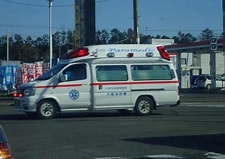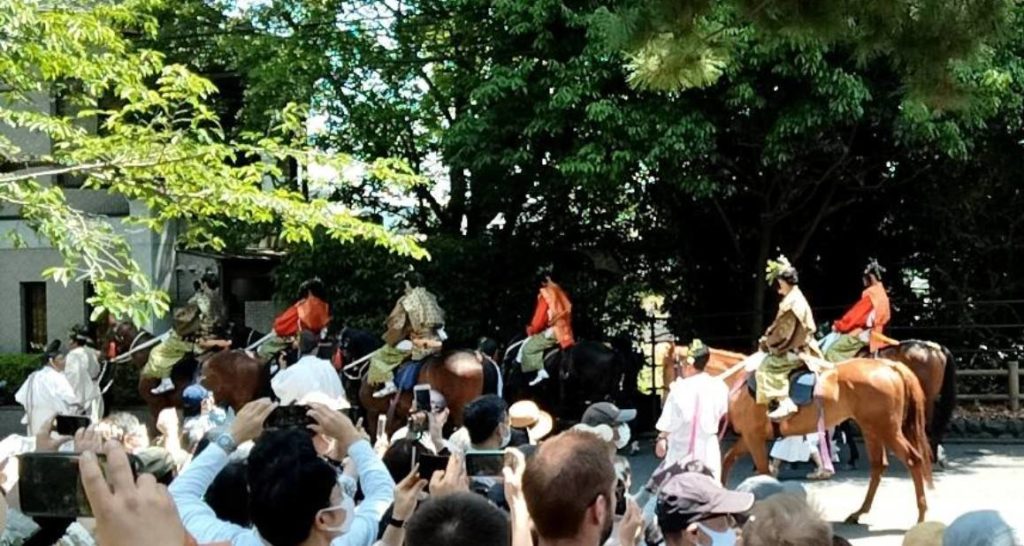アルプスは代馬消えて青田風 (2012夏 蓼科無藝荘俳句募集入選)
Green rice field’s gentle breeze
Alps’ snow horse fades away
Nature’s fleeting art.
(2012 Summer, Tateshina Mugeiso Haiku Recruitment Award)

In the Northern Alps, there exists a mountain named Mt. Shirouma or White Horse. During springtime, as the snow melts, the rocky terrain assumes the shape of a horse, giving the mountain its name. This sight also signals the planting season for rice. As time passes, the melting snow reveals the green rice seedlings, and the Alpine wind blows over the mountain. The haiku is about the farming scene during this time.
Tateshina is the location of the mountain villa that Yasujiro Ozu, who has connections with Chigasaki, established with his partner Kogo Noda to write a screenplay for summer. The former residence of Ozu, Mugeiso, is now open to the public and has exhibitions related to Ozu. Nine years ago, there was a haiku poetry competition, and I applied for it, winning a prize. The image on the left is the awarded plate.
現世より長き極楽水を打つ (2020.9.12 読売秀逸入選)
Pouring waterfalls
Paradise endures beyond
This fleeting world’s grasp
(2020.9.12 Yomiuri excellent selection)
(Review) In a world full of suffering, believe in the existence of paradise and strive to live your life to the fullest, for it is transient. The devotion to this belief is akin to the refreshing and rejuvenating feeling of cool water. This sentiment is expressed. (Kyoko Ishida)
広島の裂けたる墓石朱夏に立つ (2020.8.30 神奈川新聞入選)
Amidst Hiroshima’s heat
A tombstone stands broken
Memorializing grief
(2020.8.30 Selected for the Kanagawa Shimbun)

My house grave is in Hiroshima. The atomic bomb left the tombstone black and cracked. After consulting with the chief priest, it was decided to leave the tombstone as it is. As time passes and the moss covers the tombstone, the cracks will become less noticeable.
森をゆく甲斐のひき馬風薫る (2021.5.30 神奈川新聞入選)

Riding on horseback
Through Nagano’s wooded paths
Sweet breeze on my face
(2021.5.30 Selected for the Kanagawa Shimbun)
About two years ago, I rode a 30-minute horseback ride with my daughter’s family at a horse riding club in Kobuchizawa. It was my first experience, and when the horse turned 90 degrees down a steep slope, my body tilted and I thought I might fall off the horse. When I drove a car for the first time at the driving school, I thought that only 30km/h was a great speed. In the second half, I was able to relax and adjust my body to the movement of the horse, and I was able to enjoy horseback riding in the forest. It may be a new hobby that is likely to become addictive.
また一人去り行く麦の秋の島 (2021.6.20 神奈川新聞入選)
lonely islander
leaves the fields of wheat in bloom
parting solitude
(2021.6.20 Selected for Kanagawa Shimbun)
At last month’s haiku contest, barley bakusyuu(mature wheat) was the theme subjectted. At this time, I tried to compose several haiku that straddled on the middle phrase and the last phrase, called “Mugi no Aki XX”. The post is one of them. The first thing that comes to mind when talking about “bakusyuu” is the film of Yasujirō Ozu. This uses the kanji character 麥, which means 麥秋. At the end, there is a scene in which Setsuko Hara runs along the beach with Kuniko Miyake, and this was filmed at Chigasaki Beach. Although it was small, it is because the Eboshi Rock was reflected in the distance.
メモ帳の白き余白や新樹光 (2021.7.3 読売新聞入選)

White margins of pad
New leaves of tree shining bright
Blank canvas for thoughts
(2021.7.3 Selected for Yomiuri Shimbun)
White space, be it space or time, is gradually filled in. It may turn yellow. It’s still white. I want to cherish it.
野生馬と並走麦の秋の汽車 (2021.8.21 読売新聞入選)

golden wheat blossoms
train running side by side
with wild horse’s stride
(2021.8.21 Yomiuri Shimbun selected)
About 10 years ago, I wrote a semi-autobiographical novel about a professor of cultural anthropology who did fieldwork in Mongolia before the war. He once traveled on horseback from Zhangjiakou, Inner Mongolia, where his research institute is located, to a ranch owned by a former royal family of the Qing dynasty, 100km away. This haiku was made while recalling the teacher’s story at that time.
ランナーの靴の弾むや立葵 (2021.8.28 読売新聞入選)

amid hollyhocks
a runner’s shoe takes a bounce –
nature’s spring rhythm.
(2021.8.28 Selected for Yomiuri Shimbun)
Even during the corona crisis, there are people jogging along Uchibori-dori. The hollyhock that grew up to the height of a person was wearing a large red flower. NHK’s Taiga drama progressed from the restoration of power to the Meiji era, but if the 15th shogun had been a battle-hardened figure like Ieyasu, modern Japan would have taken a different path. I can’t help but wonder.
古事記なる出雲の海の夕焼かな (2021.9.18 読売新聞入選)

sunset on the sea
Izumo’s horizon ablaze
Kojiki’s lore lives on
(2021.9.18 Selected for the Yomiuri Shimbun)
When I was young, I knew about the splendor of the sunset over Lake Shinji from reading Jun Ishikawa’s “Shokokokujinden”. Twenty-five years ago, my wife and I visited there during the best season. My wife left a haiku, ”Golden Sunset Lake Traveling for Two of Us”. Today, September 18th, when I was selected for Yomiuri, is my wife’s birthday. When I saw the winning entry in the newspaper, I thought it was a gift from my wife.
大夕焼海の鼓動に揺られ来し (2022.7.2 読売新聞入選)

The sunset’s grandeur
In time with the rhythmic sea
Heartbeats merge as one.
(July 2, 2022, Yomiuri Shimbun selected)
My favorite course for cycling is to cross the Sagami River to the Hiratsuka side at the Banyu Bridge, get off under the embankment, go under the Tokaido Line’s iron bridge, go up the embankment again, and aim for the mouth of the river. It’s brackish water, and when the tide comes in, the waves come up the river. If it’s evening, the setting sun hits the waves that run up, and it looks as if the sunset is being carried.
短夜や新聞配るバイク音 (2022.7.9 神奈川新聞入選)
The night is short-lived
A motorcycle’s sound roars
Papers scattered wide
(2022.7.9 Selected for the Kanagawa Shimbun)
Lately, I’ve been waking up earlier, and I’ve come to notice the sound of motorbikes handing out newspapers. First came the Asahi Shimbun delivery motorbike, followed by the sound of the Yomiuri motorbike. They are delivered at almost the same time every day, so even in the dark, I can realize the approximate time.
梅雨寒や我家を目指す救急車 (2022.7.17 神奈川新聞入選)

Amidst the rain’s beat
An ambulance, towards my home
Hopes and fears compete
(2022.7.17 Kanagawa Shimbun selected)
My wife passed away 2 years and 8 months ago after battling illness for 6 years. While I was taking care of her at home, I was taken care of by an ambulance many times. I can still hear the sirens coming closer and closer to my house.
虹の橋船頭唄の潜りけり (2022.7.23 読売新聞佳作入選)
boatman’s song
drifts beneath the arch
rainbow bridge
(July 23, 2022 Yomiuri Shimbun Honorable Mention)
(Review) I don’t know where the boat was going down the river, but happened to meet a rainbow. The rainbow became a big bridge over the river. “Sendo Uta no Kuguri Keri” contains the joy of the passengers as well as the cheerful voice of the boatman. (Hisako Ueda)
光満つ中で待ちけり加茂祭 (2023.7.8 読売新聞入選)
Waiting in the light
For the Kamo Festival
To begin its march

This year, I planned my schedule so that I could see the Aoi Matsuri the next day, as my college reunion was on May 14th. However, the forecast for the 15th was rain, and the Saiodai procession was postponed to the 16th. I was able to see it because I had booked my return train in the afternoon. I crossed the Kawai Bridge at Demachiyanagi, and waited for about an hour at the entrance of Tadasu no Mori, among a large crowd of spectators. It was an exciting waiting time in the light.
